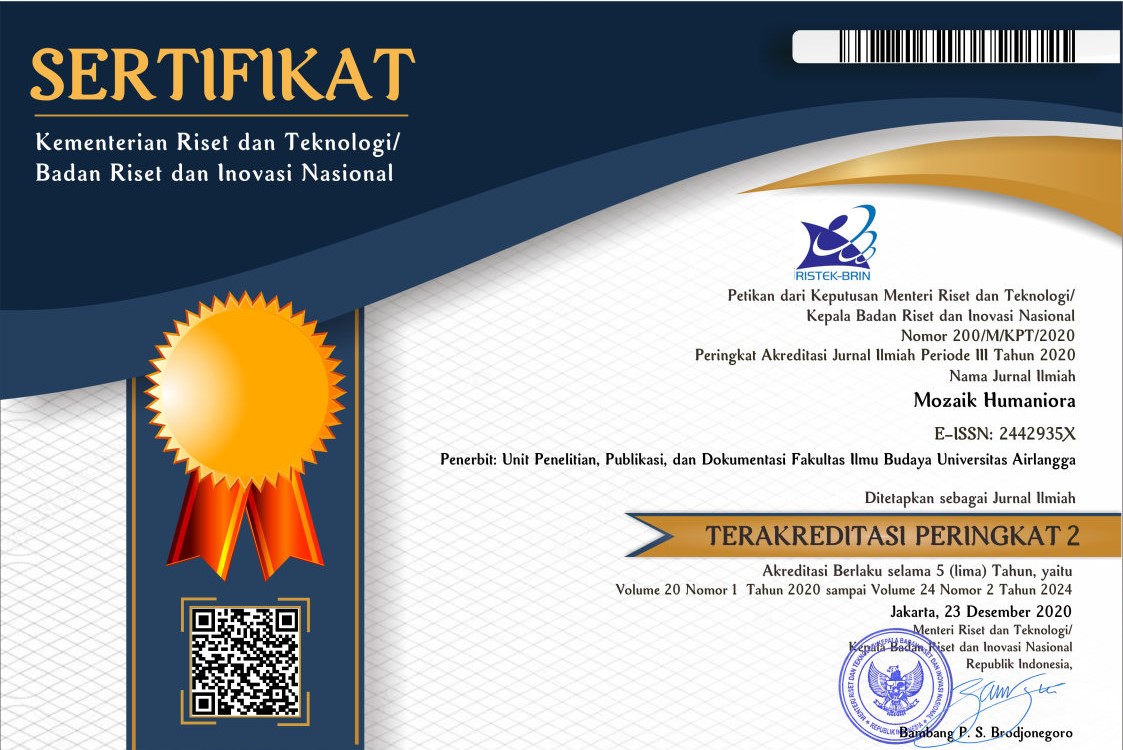The Phenomenon of Mimicry and Collective Memory in Dutch East Indies Soldier Batik Motifs
Downloads
Batik motifs are a medium for perpetuating collective memory based on the creator's point of view of social, cultural, and political conditions of the time. There are differences in meaning and ideology in batik motifs made during colonial and post-colonial era. Using the theory of collective memory and postcolonial mimicry, we want to reveal the differences in meaning and ideology between batik made during the colonial era and after independence. The method in this study is descriptive analysis, using a purposive sample of batik motifs of Dutch East Indies soldiers made by Indo-European, Indo-Arab, Chinese Peranakan, and Bumiputera entrepreneurs. The results show that the Javanese and Lombok War Batiks made during the colonial era are a medium to documentthe collective memory of the colonial community with the ideology that the Dutch East Indies soldiers were brave and great protagonists. Batik Kompeni, contrastingly, is a documentation of the collective memory of the colonized people with the ideology that the Dutch East Indies soldiers were the cruel antagonists. The findings reveal that batik is a medium of collective memory; its creation is closely related to the ideology of the batik creator.
Assmann, Aleida. 2006. "Memory, Individual and Collective.” The Oxford Handbook of Contextual Political Analysis, disunting oleh Robert E. Goodin dan Charles Tilly. DOI: 10.1093/oxfordhb/9780199270439.003.0011. https://sci-hub.hkvisa.net/10.1093/oxfordhb/9780199270439.003.0011#
"Batik Kompeni,” https://finunu.wordpress.com/category/batik-kompeni/.
"Batik Cirebon Motif Kompeni,” https://infobatik.id/batik-cirebon-motif-kompeni/).
Bertens, K. 1996. Filsafat Barat Abad XX. Jakarta: Gramedia Pustaka Utama.
Faruk H.T dan Kuswaidi Syafi'ie. 2007. Belenggu Pascakolonial: Hegemoni dan Resistensi dalam Sastra Indonesia. Yogyakarta: Pustaka Pelajar.
Gluckman, D.C., S. Muddin, dan P. Petchaburanin (eds.). 2018. A Royal Treasure: The Javanese Batik Collection of King Chulalongkorn of Siam. Katalog Pameran November 2018. Bangkok: Queen Sirikit Museum of Textiles in Bangkok.
Halbwach, M. 1992. Collective Memory, diterjemahkan oleh Lewis A. Coser. Chicago & London: The University of Chicago Press.
Loomba, Ania. 2016. Kolonialisme/Pascakolonialisme, diterjemahkan oleh Hartono Hadikusumo. Yogyakarta: Narasi.
Roediger, Henry. L, De Soto.KA. 2016. "The Power of Collective Memory.” https://www.scientificamerican.com/article/the-power-of-collective-memory/.
"Makna Batik,” https://www.youtube.com/watch?v=-l8hgXLi-oQ.
Mambrol, Nasrullah. 2016. "Mimicry in Postcolonial Theory.” https://literariness.org/2016/04/10/mimicry-in-postcolonial-theory/.
Martin, D. 2013. "Semiotika Batik Kompeni Cirebon.” Deiksis 5 (2): 150”160. DOI: http://dx.doi.org/10.30998/deiksis.v5i02.467
Noor, R. 2003. "Mimikri dan Resistensi Radikal Pribumi terhadap Kolonialisme Belanda.” Skripsi. Yogyakarta: Universitas Gadjah Mada.
Said, E. W. 2002. Covering Islam: Bias Liputan Barat atas Dunia Islam. Yogyakarta: Ikon Teralitera.
Setyowati, Yulis. 2017. "Homi Bhabha's Mimicry as Reflected in Tanizaki's Naomi.” Dinamika: Jurnal Sastra dan Budaya 5 (2): 603”612. DOI: https://doi.org/10.25139/dinamika.v5i2.628.
Singh, Amardeep. 2009. "Mimicry and Hibridity in Plain English.” https://www.lehigh.edu/~amsp/2009/05/mimicry-and-hybridity-in-plain-english.html.
"Uniknya Batik Cirebon Motif Kumpeni,” https://www.kompasiana.com/zaira/ 5519df9e813311b17b9de126/uniknya-batik-cirebon-motif-kumpeni.
Veldhuisen, H. C. 1997. Fabric of Enchantment: Batik from the North Coast of Java. Los Angeles: Los Angeles County Museum of Art.
________. 1993. Batik Belanda 1840”1940: Dutch Influence in Batik from Java History and Stories. Jakarta: PT Gaya Favorit Press.
Wattimena, R. A. A. 2016. "Mengurai Ingatan Kolektif Bersama Maurice Halbwachs, Jan Assmann, dan Aleida Assman dalam Konteks Peristiwa 65 di Indonesia.” Studia Philosohica et Theologica 16 (2): 164”196. DOI: https://doi.org/10.35312/spet.v16i2.41.
Copyright (c) 2022 Christine Claudia Lukman, Monica Hartanti

This work is licensed under a Creative Commons Attribution-ShareAlike 4.0 International License.

Mozaik Humaniora is licensed under a Creative Commons Attribution-ShareAlike 4.0 International License. Both authors and Mozaik Humaniora agree with the following attribution of journal:
1. Copyright of this journal is possession of Author, by the knowledge of the Editorial Board and Journal Manager, while the moral right of the publication belongs to the author.
2. The journal allows the author(s) to retain publishing rights without restrictions
3. The legal formal aspect of journal publication accessibility refers to Creative Commons Attribution Share-Alike (CC BY-SA).
4. The Creative Commons Attribution Share-Alike (CC BY-SA) license allows re-distribution and re-use of a licensed work on the conditions that the creator is appropriately credited and that any derivative work is made available under "the same, similar or a compatible license”. Other than the conditions mentioned above, the editorial board is not responsible for copyright violation.


















